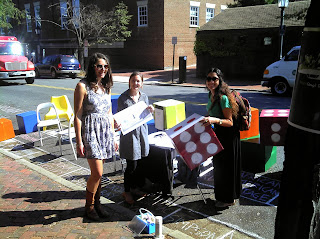 |
| photo courtesy of Dave Shove-Brown |
Most discussions about the construction and livability of
cities centers on the problematic of public and private space. We weigh in on the differences among the
Occupy encampments in POPS—privately owned public spaces-- versus true public
space. We worry about pseudo-public
spaces such as shopping malls and privatized streets. We look for and celebrate alternatives in “third
places” and DIY urbanism. We assert our
right to the city. The bright line we thought we saw between public and private
has prevented our seeing the lines within
public space. Now the prism of the federal lockout
has refracted the monolithic public into a spectrum of different publics and it’s
an unsettling sight. There’s city public and there’s federal public. Even city public cowers under the shadow of
federal public; we citizens of the District of Columbia don’t even have voting
voice in this lockout. Connections are
severed, paths blocked, daily rituals upended. Our powerlessness is exposed.
The very fabric of the city, uniquely woven from Cartesian
grid and cross-cutting diagonals knotted at green circles and squares, tells
its story of bureaucratic layers. In the
abstract, places like Lincoln Park and Dupont Circle are nodes, intermittent points
where the two street systems of the city join. In reality, each is a neighborhood center and beloved public place. They appear to be city parks, but they're not. Few of the city's defining green spaces actually belong to the city and its citizens. We just get to use them when the Park Service says we can.
De jure, they are federal spaces; de facto, they are city places.
The change in words is intentional:
space is abstract, but place is real. Our public landscapes are
inextricably woven together, not only at the custodial level of whose trash
cans are next to whose benches, or the managerial level of what behavior is and
is not allowed, but truly at the quotidian level of our everyday lives. Like
the inhabitants of one of Italo Calvino’s Invisible Cities, our buildings and
places are strung together with different strings according to the character of
our relationships: one string connects a
family to its playground, the parents to the workplace, the child to her friend’s
house, and so on. We only notice that
web when some of the strings get cut.
Ideology is the apprehension of reality at a distance. (I’m
not sure who said that; it may have been the Italian architecture theorist
Manfredo Tafuri. I should track it down, but scholarship is the first casualty
of blogging.) That distance makes decision-making so much easier, because one
can’t really see the fine-grained consequences. The ideologues can pat
themselves on the back for passing their own self-defined purity tests;
meanwhile reality itself is remarkably indifferent. Architects and planners
have learned over the years that attempts to design and implement ideal cities
inevitably fail because reality will always win. Remember that the word “utopia” really means “no
place.” All building, all place-making
is political in that it has to involve compromise. I tell my students that all space is
political; now I see that all politics is spatial.



